This post is a presentation of archaeological findings, from the territory of modern Bulgaria, which imply intense Mycenean presence in ancient Thrace.
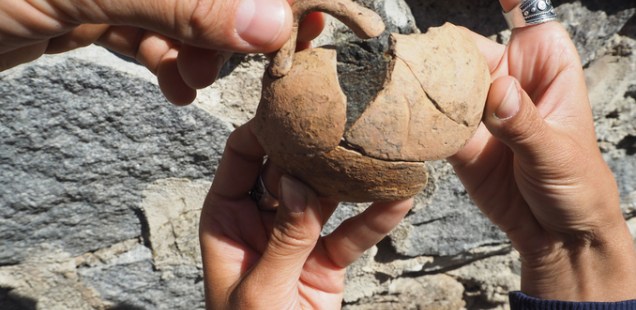
Abstract This contribution discusses the Late Bronze Age site of Dragojna, which is situated at the northern fringe of the Rhodope Mountains in Bulgaria. The local ceramic find material is presented in representative quantity, classified according to its regional and transregional context, and evaluated in terms of its significance for the dating of the settlement site and the relative dating of Late Bronze Age cultural groups in the central Balkan region. In addition to handmade local pottery, fragments of Mycenaean ceramics were also found at Dragojna. The latter are classified typologically and chronologically and their provenance – a coastal area of Thessaly – is determined by means of chemical analysis (neutron activation analysis). Finally, Mycenaean contacts with the Thracian regions in the middle Mycenaean period are summarized and discussed against the background of the new finds from Dragojna and taking account of the Aegean-type bronze weapons known from Bulgaria.
(Source: “Dragojna. A late bronze age hilltop settlement in the Bulgarian Rhodopes with imported Mycenaean pottery”, by E. Bozhinova et al., 2010)
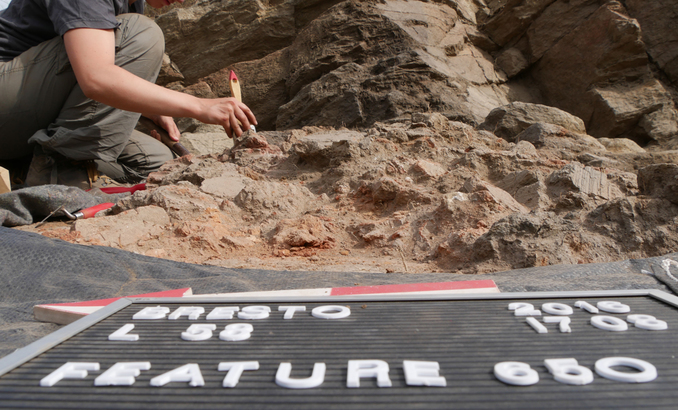
In addition to the bronze weapons of the Mycenaean type, which have been known for some time, Mycenaean ceramics have increasingly been added to the range of finds in the Eastern Balkans in recent years. However, the occurrence of secured Mycenaean type vessels in the Thracian area is still very limited. Against this background, the availability of new analysis results on the origin of the Mycenaean ceramics found in Koprivlen offers a welcome opportunity to dedicate a short contribution to the most important Mycenaean ceramics found in Bulgaria and to place them in their regional and national social and economic context.
It primarily deals with the Dragojna sites in the northern central Rhodopes and Koprivlen. The Mycenaean pottery of these two settlements was analyzed with neutron activation analysis (NAA) for the purpose of origin determination in the Bonn laboratory.
Dragojna
The findings and ensemble of finds
A few years ago, a complex of finds from Mycenaean vessels and the accompanying local repertoire of hand-made ceramic categories from the Dragojna highlands in the Central Rhodopes, which was important for the evaluation of the Mycenaean-Thracian contacts, was presented. The site is located on two peaks of the mountain, called Goljama (large) and Malka (small) Dragojna, while the area between the peaks remained uninhabited in the late Bronze Age. The place thus comprised two separate settlement areas. It is currently unclear whether the two sectors were inhabited at different times. Large quantities of ceramics were found in both places, but only a few building structures were preserved after the intensive use of the site. Two retaining walls on the middle terrace of Malka Dragojna and a floor level between the rocks of Goljama Dragojna were examined during ten excavation campaigns. The floor was carefully laid from two successive layers of broken glass and stone to level the terrain, which was most likely used to create a house. Between these shards and in the areas adjacent to the floor, some fragments of imported, mostly Mycenaean turntable vessels were found. Few other fragments of imported turntable vessels, which could be identified from the finds of handmade local ceramics by both the Goljama Dragojna and the Malka Dragojna, cannot be classified with certainty, since they are only very small fragments and only remnants are on their surface linear decorations. This extensive import spectrum compared to other simultaneous localities north of the Aegean coastal region distinguishes Dragojna as an important and rich center in the Thracian area.
The hand-made ceramics from Dragojna is a classic example of a find ensemble of Late Bronze Age South Bulgarian ceramics of the Rhodope variant. It is of high quality and richly decorated with various geometric motifs. The spectrum of vessel types and patterns speaks for a dating in the developed phases of the period, between the 15th and 13th centuries BC. u. Z. Since there is still no chronological sequence for the shape and pattern development of Bulgarian Late Bronze Age ceramics, no phase-specific dating of the site is currently possible. There are a few vessels from both the Goljama and the Malka Dragojna, the shapes and decoration techniques of which are among those that were common in earlier periods of the Bronze Age. They offer indications of the chronological approach of the beginning of settlement at the end of the Middle or at the beginning of the Late Bronze Age (16th century BC). It is not clear whether Dragojna was also settled in the last phase of the Late Bronze Age and at the transition to the Iron Age.
Mycenaean ceramics
There are five clearly Mycenaean fragments from at least four different vessels: three or four FT 255 trophies and a small closed vessel. The cup fragments can be relatively dated. They can be assigned to phase SH IIIA1 using stratified parallels from southern Greece. The shoulder fragment of a small closed vessel can also have been produced in this time phase.
The NAA in Bonn assigned the four sampled Mycenaean fragments, i.e. three cup fragments and the fragment of the small closed vessel, into a single chemical group. This could be assigned to a Mycenaean pottery in Dhimíni due to correspondences with modern clay in Dhimíni near Vólos.
The traffic routes to the south
One of the most important traffic routes that connected the valley of the Maritsa (Hebros / Evros) with the Aegean coast may have been through the region of Dragojna. A road was in use here during the Hellenistic and Roman times, and it is very likely that it dates back to the late Bronze Age.
Koprivlen
The findings and ensemble of finds
The site of Koprivlen is at the foot of the southeast slopes of the Pirin Mountains. The settlement is on the ancient road that connected northwest Thrace to the Aegean through the Nestos and the Drama plains. It was partially excavated in 1998 and 1999.
The excavations revealed two late Bronze Age building horizons, the older second building horizon (time phase Koprivlen I) and the younger first building horizon (time phase Koprivlen II), as well as a number of early Iron Age structures. The Late Bronze Age houses were loosely arranged over a length of at least 60 m. The building structures of the older Late Bronze Age building level were built using the wattle technique used in the region.
As the Late Bronze Age progressed, a new settlement was built on the remains of the older one, but using a different construction technique. In the excavated section, two long walls were uncovered, which had probably served as retaining walls and ran parallel to each other from the northwest to the southeast at a distance of about 10 m. These walls were built from medium to large stones, and their foundations can be up to four rows of stones. Houses and other structures had been erected on either side of the walls. They have stone foundations of the same construction as the long walls, while the rising masonry consisted of mud bricks, which can only be traced back to the southern influence.
Although only a small part of the settlement was examined, a certain settlement plan can be seen quite clearly, which consists of long, parallel retaining walls and houses and alleys / streets arranged in between. The houses were oval or apsidal in shape and in some cases also included the long retaining walls. Hearths similar to those from the older settlement level, as well as large stoves, were uncovered inside the houses. Pithoi had been embedded in pits inside and outside the houses.
The ceramic find material of the Mycenaean type from Koprivlen comprises fragments of five to six vessels and seven completely rubbed wall fragments, about whose possible affiliation with the aforementioned vessels nothing more can be said. These vessels come from four different houses from the younger settlement phase Koprivlen II or were found in their immediate vicinity.
Mycenaean ceramics
From the floor of structure 26-30, which unfortunately cannot be added to a complete house floor plan, comes the edge fragment of a skyphos FT 284 / 285A, which is decorated on the outside with a narrow edge band. The vertical purple snail with a filled opening (FM 23, 3) is a pattern that only appeared frequently on skyphoi in southern and central Greece in the early phases of the LH IIIB period and was then only used very rarely for painting this open type of vessel.
Two non-matching edge fragments from structure 23-60 can be assigned to a large shoulder handle amphora (FT 34/35). The smaller shard shows clear burn marks and black organic substances. However, the state of preservation is sufficient to identify residues of the same stripe pattern on the lip that adorn the larger fragment. It is a high quality pottery, the painting must have been shiny originally. Shoulder amphoras of this kind are usually found less frequently in settlements in southern and central Greece and more often than in the late Mycenean chamber tombs, which have been repeatedly documented. In northern Greece there is individual evidence of the type from Central and Eastern Macedonia.
An outside fragment of a small closed vessel with an almost unthickened and only slightly bent lip comes from structure 23-60. Due to better preserved parallels, it may have belonged to a rounded Alabastron FT 85, FT 86, a square Alabastron FT 94/96/97, a late shoulder amphorisk FT 48 or an abdominal handle amphorisk with two FT 59 or three handles FT 61. The cited parallels from different regions of Greece allow dating from LH IIIB middle to LH IIIC early, although a somewhat later date cannot be ruled out, especially since nothing of the shoulder of the vessel is preserved from Koprivlen. The wall fragment of a small open vessel made of structure 25-10 can be assigned to a Kylix FT 257 with caution. This is indicated by the course of the wall in combination with the pattern, an oblique purple snail FM 23.5, as was often used to decorate this type of vessel in all Mycenaean regions. The monochrome interior decor of Kylikes FT 256–258B was not in the Peloponnese, but it was common in Central Greece and Thessaly as well as in Central and Eastern Macedonia.
The last two wall fragments from structure 35-10 by Koprivlen are to be mentioned, which should have belonged to a Skyphos FT 284/285 with a monochrome interior decor (Skyphos B or C56). His goods clearly distinguish this vessel from those from structure 23-60. Single wide curved horizontal wavebands are the most common or second most common patterns of the skyphoi A and the skyphoi in Central Macedonia, which are monochrome on the inside. Exact parallels in shape, decor and pattern for the vessel from Koprivlen were made in Kastanás, layer 14b (LH IIIC early), Ássiros A, phases 9 and 7 (LH IIIA late to LH IIIB early or LH IIIC), on the Toumba from Thessaloníki in phase 4 (LH IIIC developed early to maximum IIIC) and found in Periwoláki.
Since the Mycenaean vessels from Koprivlen all belong to the younger settlement phase of Koprivlen II, but within which no fine stratigraphic sequence of the buildings could be determined, the younger, so-called first building horizon can be specified as the total period of use of Mycenaean ceramics in Koprivlen and these with phases LH IIIB Synchronize early to LH IIIC early (possibly also with LH IIIA late). This maximum range results from the combination of the chronologically meaningful features of Mycenaean ceramics, whereby the skyphos A with a vertical purple snail specifies the safe upper time limit. The possible even earlier approach from LH IIIA Late depended only on the Kylix fragment with slanted purple snail, which is difficult to date due to its monochrome inside. The remaining fragments suggest an approach in the second half of the chronological framework mentioned. The evaluation of the handmade ceramics also provides information that should be interpreted in this sense. Thus, the Mycenaean material from Koprivlen as a whole dates back to a significantly later historical period than that from the settlement of Dragojna.
Neutron activation analysis of five Mycenaean vessels from Koprivlen and evaluation of the analysis data
Analysis of the concentration patterns of the samples from Koprivlen revealed the origin of two vessels, Kopriv 2 and 5, which have a composition that we already know. The remaining three are chemical cases. No further conclusions can be drawn from the individual chemical cases. They can either represent a clay recipe from a previously unknown pottery workshop, or they were contaminated in the Bronze Age or in our laboratory.
The sample Kopriv 2 of the vessel No. 3 is similar in composition (apart from a small deviation in the Cs value) to a large group of 46 samples called AkaR and assigned to the region of Aitoloakarnanía. This assignment is based only on the distribution of finds among the group members who come mainly from this area. A good reference sample is unfortunately not available for this group, so that the origin of Kopriv 2 from Aitoloakarnanía cannot be considered as certain.
Also for the second sample of a known sample, Kopriv 5 from Cat. No. 2, only a general region of origin can be determined.
Again, the exact location of the workshop that processed the clay of this composition is unknown, but almost all of the group members come from Macedonia in northern Greece, so it is highly likely that the small closed jar Cat. 2 was made in Macedonia.
(Source: “Mykenische Keramik in der Rhodopenregion. Herkunft, regionaler Kontext und sozialökonomische Grundlagen”, by Reinhard Jung et al., 2017 – translated from German)
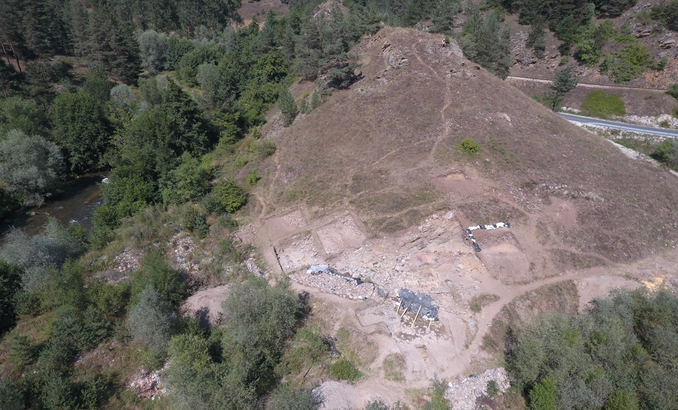
“The affinity of Thracian religion to the people of the Eastern Mediterranean (Aegean, Mycenean, Cretan) is indisputable.”
(Source: “Rock sanctuaries in the Struma Valley”, by Philip Mihaylov, 2017)
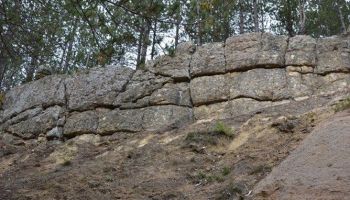
A partly preserved alabastron, a vessel for perfumes, from Ancient Mycenae has been discovered by archaeologists excavating a 3,300-year-old fortified Bronze Age settlement near the town of Banya, Razlog Municipality, in Southwest Bulgaria.
The artifact dating back to 1,300 BC testifies to the connections between the civilization of Mycenaean Greece and Bronze Age Ancient Thrace in today’s Southwest Bulgaria, and especially in the Razlog Valley located between the Rila, Pirin, and Rhodope Mountains.
The discovery of the Mycenaean vessel in the fortified Bronze Age settlement located in an area called Bresto near the towns of Banya and Razlog has been made by an international team of archaeologists and archaeology students, New Bulgarian University in Sofia has announced.
The excavations have been led by Assist. Prof. Bogdan Atanasov from the Archaeology Department of New Bulgarian University, Prof. Dr. Philipp W. Stockhammer from Ludwig-Maximilian University in Munich, Germany, and Iliya Kulov from the Regional Museum of History in Bulgaria’s Blagoevgrad.
They featured participating by students from New Bulgarian University and Ludwig-Maximilian University in Munich, and thanks to the Field School of the Balkan Heritage Foundation, students from the USA, UK, and Australia.
While Ancient Greek pottery from later periods (such as the Golden Age of Athens) is often discovered in Bulgaria’s archaeological sites from Ancient Thrace, especially in the southern parts of the country, Mycenaean pottery is a rare find.
“Mycenaean pottery has only very rarely been found in Bulgaria,” says New Bulgarian University regarding the discovery.
“The find dating back 33 centuries sheds new light on the relations between the mountain regions of Southern Bulgaria and the urban centers in the Aegean Region at the time of the Mycenaean palaces,” it adds.
It is noted that another artifact discovered during the excavations of the Bronze Age settlement near Banya and Razlog offers further evidence of these ties: a lamella made of a wild boar’s tusk “which was probably prepared for the production of a ceremonial Mycenaean helmet”, i.e. a boar’s tusk helmet.
The precise content of the partly surviving Mycenaean alabastron is yet to be established with analysis of the organic residue in it.
The archaeological site of the fortified Bronze Age settlement in the area known as Bresto in Bulgaria’s Razlog Valley is located on the slope of a hill surrounded from three sides by the Iztok River, a tributary of the Mesta River (known as Nestos in Greece) which flows into the Aegean (Mediterranean) Sea.
The Mycenaean vessel was discovered in a small passage next to a huge building with an apse.
The University points out that in the 13th century BC, at the time when the first fortified Bronze Age settlement emerged in Bresto in today’s Southwest Bulgaria, new defensive structures were constructed in the more important settlements of Mycenaean Greece.
It cites ancient sources in Linear B writing, the syllabic script used for Mycenaean Greek, as revealing that some Mycean palaces took defense measure, and adds that in the early 12th century BC, the Eastern Mediterranean was rattled by political and economic crises leading to the demise of the Mycenaean Civilization and the breakup of the Hittite Kingdom in Anatolia (Asia Minor). The archaeologists have found that this was the time when the Bronze Age settlement in Bresto was abandoned.
“For the time being, no such massive fortification walls [from the Bronze Age] such as the one in Bresto have been discovered in Western Bulgaria or Northern Greece,” says New Bulgarian University, adding,
“The closest resemblance to the wall from Bresto can be found in the sixth settlement of Troy.”
The archaeological excavations in Bresto are said to be aimed at a better understanding of the wealth and distant relations of the strongly fortified Bronze Age settlement located between the mountains of Rila, Pirin and Rhodope.
The excavations have been carried out with the funding and logistical support from New Bulgarian University, Heidelberg University, LMU Munich, the Balkan Heritage Foundation, the Institute for Field Research, Bulgaria’s Ministry of Culture, Razlog Municipality and the town of Banya, Valeks Group 2 in Razlog, and the St. Paisiy Hilendarski (Paisius of Hilendar) School in Banya.

An ancient fortress which is 3,000 – 3,200 years old and was built with the so called Cyclopean masonry has been found by archaeologists in Bulgaria’s Rhodope Mountains, near the town of Zlatograd and the border with Greece, and is taken as evidence that Ancient Thrace was part of the Mycenaean Civilization.
The previously undetected fortress is roughly dated to 1,200 BC, i.e. to the time of Ancient Troy and the Trojan War.
It is located near Zlatograd, Bulgaria’s southernmost town, near the southern slopes of the Rhodope Mountains, in an area that is only about 20 kilometers away from the coast of the Aegean (Mediterranean) Sea.
The Cyclopean masonry used to erect the fortress wall of the newly found Ancient Thracian city is typical precisely of Ancient Mycenae and the Crete – Mycenaen Civilization: it is built of enormous boulders without any mortar, not unlike the fortress walls of Mycenae, Tiryns, and Troy.
The Cyclopean masonry fortress near Zlatograd has been found by accident by an archeological expedition which earlier this month discovered the site of an Ancient Thracian royal residence from the 5th – 4th century BC located near the town of Benkovski, in the neighboring Kirkovo Municipality.
Each of the boulders used for the construction of the newly found Bronze Age fortress weighs approximately 5 metric tons.
“This is one of the first testimonies of the so called Mycenaean Thrace, a [fortified] residence from 3,000 – 3,200 years ago. The fortress wall and the pottery that we discovered indeed speak of the period of the Trojan War,” archaeologist Prof. Nikolay Ovcharov has told the Bulgarian National Television.
Behind the fortress wall, his team has explored what they believe were two public buildings and a shrine as well as a necropolis, and a fortified castle. These are believed to be the remains of a major city from Ancient Thrace from the time of Achilles, Hector, and Odisseus
“The fortress wall was built using the Cyclopean masonry typical of the 13th – 11th century BC, the same type as in key sites such as Troy, Mycenae, and Tiryns, the centers of the Mycenaean Civilization,” Ovcharov has told BTA.
Nearly 50 years ago, late Bulgarian scholar Prof. Alexander Fol (1933 – 2006), the founder of thracology, the study of the civilization of Ancient Thrace, was the first to voice the hypothesis that early Thrace was part of the Crete – Mycenaean Civilization, which is widely recognized as Europe’s first Antiquity civilization.
Ovcharov sees the discovery of the Cyclopean masonry fortress near Bulgaria’s Zlatograd as evidence in support of Fol’s theory.
He points out that according to Fol’s hypothesis, the Thracian kings from the period of the Trojan War had their own fortified residences built with Cyclopean masonry. However, until the fortress discovery there had been few tangible arguments to support it.
“And now, in the heart of the Rhodope Mountains, we’ve come across a fortress which leaves no doubt that it was built in this way,” Ovcharov underscores, noting that the only other Cyclopean masonry in Bulgaria known up till now is found in the Nebet Tepe Fortress in the city of Plovdiv.
As the Cyclopean masonry fortress has been found during the archaeological expedition that found a Thracian royal residence from a later period, Ovcharov hypothesizes historical continuity.
The expedition lead by Assoc. Prof. Zdravko Dimitrov from the National Institute and Museum of Archaeology has been based on a number of finds from the area discovered over the past few years, including the rock grave of a dismembered Thracian princess containing jewels from the 4th – 3rd century, the ruins of a complex of monumental buildings, and a stone wall from the same period located not far from the Cyclopean masonry fortress.
An Ancient Thracian toy stork dubbed the oldest child toy in Europe from the Late Bronze Age, ca. 1,500 – 1,200 BC, has also been found in the area.
“This here was probably an Ancient Thracian residence [from ca. 1,200 BC] which continuing to function during the first millenium BC as well,” Ovcharov hypothesizes.

Archaeologists have discovered Tuesday a Mycenaean bronze sword cap in an ancient Thracian sanctuary in Bulgaria.
The artifact was unearthed in the sanctuary, which is situated in between ten rock tombs in Arda River valley near the village of Dolno Cherkovishte.
The marble cap has once been put at a bronze sword haft and was among the gifts, presented by the Thracians at the sanctuary more than 1,300 years ago.
“The find dates from 15th century BC and it is typical for the Mycenaean armament,” the archaeologist Georgi Nihrizov explained.
That is the second marble cap, discovered by his group. The first one was found few years ago near the town of Krumovgrad.
“We have also discovered several religious fireplaces and different kind of gifts in the sanctuary,” Nihrizov added.
The rock, where the sanctuary is situated has the form of a lying lion. It is surrounded by tombs, fortresses and an ancient hamlet, which will be objects of further excavation works.
(Source: https://www.novinite.com/articles/81791/Mycenaean+Sword+Cap+Found+in+Thracian+Sanctuary+in+Bulgaria)

The Bulgarian archaeologists Daniela Agre and Deyan Dichev, who are leading the Strandzha expedition, unearthed a royal frieze near the village of Golyam Dervent. Dichev and Agre were researching a dolmen (dolmens were the first Thracian tombs) when they noticed a frieze of intertwined zoomorphic and geometrical elements carved on the entrance of the tomb. The most interesting part of the discovery is the double-axe (labris) – a symbol of power in the Thracian society – placed inside a circle. The labris has lots of additional ornamentation on it, Dichev said. The frieze includes the images of snakes, which were the symbol of the king in the Thracian religious beliefs.
Archaeologists have also discovered a Mycenaean bronze sword cap in an ancient Thracian sanctuary in Bulgaria. The artifact was unearthed in the sanctuary, which is situated in between ten rock tombs in Arda River valley near the village of Dolno Cherkovishte. The marble cap has once been put at a bronze sword haft and was among the gifts, presented by the Thracians at the sanctuary more than 1,300 years ago. “The find dates from 15th century BC and it is typical for the Mycenaean armament,” the archaeologist Georgi Nihrizov explained.
(Source: http://passionateabouthistory.blogspot.com/2007/06/royal-frieze-unearthed-in-bulgaria.html)
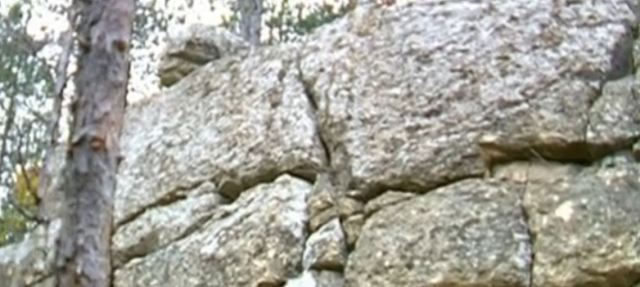
A 3,000 year old ancient fortress was discovered by archaeologists near the South Bulgarian town of Zlatograd. The fortification is from the times of Troy and Mycenae and is one of the first evidence that ancient Thrace was part of the Cretan-Mycenaean culture, believed to have been the first civilization in Europe. Researchers suggest that the town of the legendary Achilles, Hector and Odysseus was located behind the fortress, reports BNT.
The archaeological expedition was exploring a Thracian royal residence from the 4th- 5th centuries before the common era, when they came upon a fortress, which was nearly a thousand years older. The walls are made of huge stones weighing more than 5 tonnes. This is the so-called Cyclopian building, with it being built the ancient Troy, Mycenae and Tyrint.
Nearly 50 years ago, academician Alexander Foll first speculated that Thrace was part of the renowned Cretan-Mycenaean civilization. Archaeologists now have proof of this.
Prof. Nikolai Ovcharov: This is one of the first testimonies of the so-called Mycenean Thrace. A residence dating back to 3,000 – 3,200 years ago. The fortress wall we found, as well as the ceramics, actually indicate it was the period of the Trojan War.
Behind the fortress wall, the archaeologists found a royal necropolis, a sanctuary and a fortified castle. Two buildings with representative features and a sanctuary were studied. The area is filled with stone altars, it is supposed that there is a city, which is more than 3,000 years old. The expedition is funded for the fifth consecutive year by the Regional Ethnographic Museum in Zlatograd.
Alexander Mitushev, Manager of the Areal Ethnographic Complex in Zlatograd: What we have set as our goal is to help science and of course we can promote the region with the archaeological sites that can be visited by the local residents, guests and tourists.
(Source: https://www.novinite.com/articles/192745/Archaeologists+Discover+3%2C000+Year+Old+Fortress+near+South+Bulgarian+Town+of+Zlatograd)
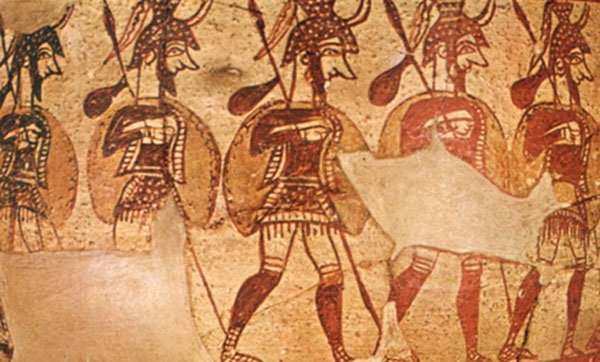
A recent study has plausibly shown that contacts between Bulgaria and the Mycenaean world were most intense during the LH IIB and LH IIIA1 phases in the 15th and early 14th centuries. The contacts are primarily evidenced by swords and spear heads of the Aegean type from diverse Bulgarian locations. A few LH IIIA1 sherds from Dragojna on the northern fringe of the Rhodope Mountains are a recent addendum to the Aegean finds from the territory of present-day Bulgaria. According to the results of neutron activation analysis the Mycenaean pottery from Dragojna was produced in the region of Volos in southern Thessaly. A quite surprising indication for some contact between the southeast Balkans and the eastern Mediterranean during the Mycenaean palatial period was the discovery of a ceremonial stone axe or sceptre with parallels in Bulgaria and Romania on the Uluburun wreck, which sunk off the southwest coast of Asia Minor in the second half of the 14th century.
Archaeological evidence indicates that there was some contact between the southern Balkans and the Mycenaean world during the palatial period.
According to current knowledge, exchange between the territory of present-day Bulgaria and Mycenaean Greece reached a peak just before and at the beginning of the palatial period and declined afterwards.
(Source: “Did the terms ‚wanax‘ and ‚lāwāgetās‘ already exist before the emergence of the Mycenaean palatial polities?”, by Florian Ruppenstein, 2015)

Note: To avoid misunderstandings, the last two photos do not come from Bulgarian excavations.
Research-Selection for NovoScriptorium: Philaretus Homerides
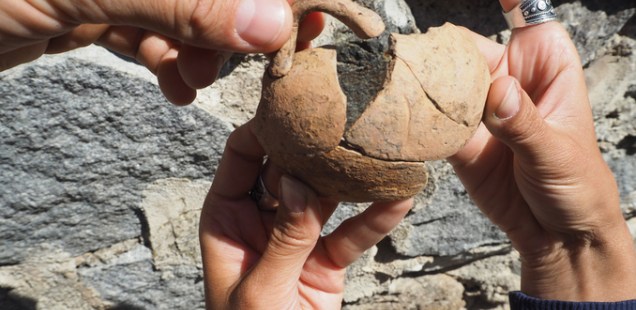
Reblogged this on gutzko.
LikeLike